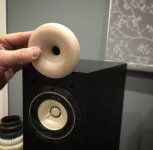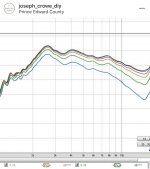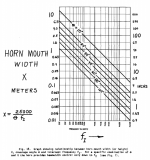I saw a number of recent threads asking some pretty fundamental questions about horns and waveguides and how the various types differ.
The following is my attempt to provide some guidance.
There are fundamentally SIX types of horns that you can use, and they all have their pro’s and con’s.
1) VERY old school symmetrical round or square exponential/hypex horns. Examples of these would be the early WE ones and the ones still used in those Japanese Goto, Ale, etc. Installations. These horns (i) load the drivers well down to the horn’s cutoff, and (ii) equalize the compression driver’s natural high-frequency mass-induced roll-off at the high frequencies, resulting in pretty flat on axis, but they beam a lot. They also lead to some pretty serious reflections at the mouth, unless they are either used only above 2-3x cutoff, and/or are improved with some suitable additional round-over at the mouth. The axi-symmetric JMLC horns fall into this camp, and they are arguably the best at addressing the mouth reflection issue.
2) Old school exponential/hypex radial horns. Examples of these would be the old Altec “sectoral” horns, like the 511 and 811, or the Fostex radials (H420, H320, H220, H400, H300, etc.). These still achieve the same (i) and (ii) feats above, but they manage to also yield almost constant directivity on the Horizontal plane over much of their bandwidth (at the expense of vertical coverage, which is monotonically decreasing and even narrower overall). The more “classic” radials also have some issues with internal reflections and diffraction, because of the abrupt profile discontinuity at the throat. But, these latter issues can be mitigated by clever design improvements, as done in the Yuichi Arai horns, as well as in several other similar Japanese wooden horns like those by Yamamoto, Ta-On, GT Sound, etc. I PERSONALLY CONSIDER THESE TO BE THE BEST OVERALL COMPROMISE FOR HOME HI-FI, but of course I’m aware that it’s all a matter of picking one’s favourite trade-offs, and that others may disagree, and for very valid reasons.
3) Tractrix horns. These tend to be very similar to n. 1), but with reduced mouth reflections, and poorer driver loading towards the lower end of their bandwidth. The main problem I have with these is that the theory on which they are based is very shaky. In simple terms, the tractrix profile “looks” nice but there is no sound physical justification for it whatsoever. So I don’t consider it a very credible contender, especially given that the JMLC horns (see 1) tend to solve the same issues and offer improved loading.
4) Conical horns. These are essentially simple “funnels” with straight walls that simply constrain the driver’s radiation into a solid angle of choice. There are two BIG problems with them, though: (i) they do NOT load the drivers effectively at all, resulting in very poor low frequency extension even in the case of very large horns, and (ii) they present the worst possible abrupt discontinuities at the throat and at the mouth, resulting in awful reflections and diffraction. In other words, in my humble opinion, why bother?
5) Modern “constant directivity” horns. JBL and Altec were the first to develop these in the 70s/early 80s, with the aim of ensuring a more homogenous coverage of the venues served by PA systems in Pro sound applications. The main problem with these early efforts was that the profile was decomposed into two sections: a very short expo/hypex throat section, expanding in only one dimension, and feeding a second conical section through a diffraction slot. While this achieved the desired constant directivity, while also giving marginally better loading than a simple conical horn, there were serious drawbacks in terms of (i) diffraction, and (ii) still poor loading nonetheless. The JBL 2385 is a typical example of these horns. All the later JBL horns use in their home products such as the K2 S9800, S9900, etc. still essentially belong to this camp, but they backtracked a little on the diffraction slot, smoothening it to reduce the severity of the effect, and in so doing also giving up a bit of directivity control...
6) Even more modern “constant directivity” waveguides. These are the result of a radical re-thinking of the purpose of having horns in the first place. Basically, their rationale is that today power is cheap and we don’t really need efficiency and loading any more; all we should aim for is directivity control, AND the least possible amounts of diffraction. The best examples of these are Earl Geddes’ OS waveguides. They are essentially conical over most of their expansion, but with an ideal, mathematically-derived throat section that transitions from the planar wavefronts at the compression driver exit to the spherical wavefronts within the conical part of the waveguide. Loading is still very poor, but at least they are (very) good at something, I.e. diffraction minimization. To me, if you buy into the argument that directivity control is essentially all that matters, these are a much better proposition than the “constant directivity” designs at point 5) above.
So, there you have it. As I said many times already... pick your poison! ��
Marco
The following is my attempt to provide some guidance.
There are fundamentally SIX types of horns that you can use, and they all have their pro’s and con’s.
1) VERY old school symmetrical round or square exponential/hypex horns. Examples of these would be the early WE ones and the ones still used in those Japanese Goto, Ale, etc. Installations. These horns (i) load the drivers well down to the horn’s cutoff, and (ii) equalize the compression driver’s natural high-frequency mass-induced roll-off at the high frequencies, resulting in pretty flat on axis, but they beam a lot. They also lead to some pretty serious reflections at the mouth, unless they are either used only above 2-3x cutoff, and/or are improved with some suitable additional round-over at the mouth. The axi-symmetric JMLC horns fall into this camp, and they are arguably the best at addressing the mouth reflection issue.
2) Old school exponential/hypex radial horns. Examples of these would be the old Altec “sectoral” horns, like the 511 and 811, or the Fostex radials (H420, H320, H220, H400, H300, etc.). These still achieve the same (i) and (ii) feats above, but they manage to also yield almost constant directivity on the Horizontal plane over much of their bandwidth (at the expense of vertical coverage, which is monotonically decreasing and even narrower overall). The more “classic” radials also have some issues with internal reflections and diffraction, because of the abrupt profile discontinuity at the throat. But, these latter issues can be mitigated by clever design improvements, as done in the Yuichi Arai horns, as well as in several other similar Japanese wooden horns like those by Yamamoto, Ta-On, GT Sound, etc. I PERSONALLY CONSIDER THESE TO BE THE BEST OVERALL COMPROMISE FOR HOME HI-FI, but of course I’m aware that it’s all a matter of picking one’s favourite trade-offs, and that others may disagree, and for very valid reasons.
3) Tractrix horns. These tend to be very similar to n. 1), but with reduced mouth reflections, and poorer driver loading towards the lower end of their bandwidth. The main problem I have with these is that the theory on which they are based is very shaky. In simple terms, the tractrix profile “looks” nice but there is no sound physical justification for it whatsoever. So I don’t consider it a very credible contender, especially given that the JMLC horns (see 1) tend to solve the same issues and offer improved loading.
4) Conical horns. These are essentially simple “funnels” with straight walls that simply constrain the driver’s radiation into a solid angle of choice. There are two BIG problems with them, though: (i) they do NOT load the drivers effectively at all, resulting in very poor low frequency extension even in the case of very large horns, and (ii) they present the worst possible abrupt discontinuities at the throat and at the mouth, resulting in awful reflections and diffraction. In other words, in my humble opinion, why bother?
5) Modern “constant directivity” horns. JBL and Altec were the first to develop these in the 70s/early 80s, with the aim of ensuring a more homogenous coverage of the venues served by PA systems in Pro sound applications. The main problem with these early efforts was that the profile was decomposed into two sections: a very short expo/hypex throat section, expanding in only one dimension, and feeding a second conical section through a diffraction slot. While this achieved the desired constant directivity, while also giving marginally better loading than a simple conical horn, there were serious drawbacks in terms of (i) diffraction, and (ii) still poor loading nonetheless. The JBL 2385 is a typical example of these horns. All the later JBL horns use in their home products such as the K2 S9800, S9900, etc. still essentially belong to this camp, but they backtracked a little on the diffraction slot, smoothening it to reduce the severity of the effect, and in so doing also giving up a bit of directivity control...
6) Even more modern “constant directivity” waveguides. These are the result of a radical re-thinking of the purpose of having horns in the first place. Basically, their rationale is that today power is cheap and we don’t really need efficiency and loading any more; all we should aim for is directivity control, AND the least possible amounts of diffraction. The best examples of these are Earl Geddes’ OS waveguides. They are essentially conical over most of their expansion, but with an ideal, mathematically-derived throat section that transitions from the planar wavefronts at the compression driver exit to the spherical wavefronts within the conical part of the waveguide. Loading is still very poor, but at least they are (very) good at something, I.e. diffraction minimization. To me, if you buy into the argument that directivity control is essentially all that matters, these are a much better proposition than the “constant directivity” designs at point 5) above.
So, there you have it. As I said many times already... pick your poison! ��
Marco
Last edited:
Marco, can you talk a bit more about "loading" ?
Im not sure I have enough understanding here. I have been doing some work on waveguides used with small ribbons. I understand its not exactly the same as a compression driver etc BUT I get quite usable lower freq sensativity increase with these and thought this was a result, in part anyway, from "loading". Or is it simply doing the "directivity" thing and thus the in window lower freq sensitivity increase.
At the moment these small ( 75mm long ) ribbons are being used down to 800hz in the waveguide at 95 db sens. ( they are used to about 1.2khz as direct radiators at 88 db sens) .There +- 1db from 800 to 10khz BUT then roll off to abot -7db at 20K
Im not sure I have enough understanding here. I have been doing some work on waveguides used with small ribbons. I understand its not exactly the same as a compression driver etc BUT I get quite usable lower freq sensativity increase with these and thought this was a result, in part anyway, from "loading". Or is it simply doing the "directivity" thing and thus the in window lower freq sensitivity increase.
At the moment these small ( 75mm long ) ribbons are being used down to 800hz in the waveguide at 95 db sens. ( they are used to about 1.2khz as direct radiators at 88 db sens) .There +- 1db from 800 to 10khz BUT then roll off to abot -7db at 20K
Last edited:
Marco what about patent 2,690,231? 🙂
That is certainly an interesting early attempt to control directivity.
In practice, it would still fall under category 5), though.
Marco
Observations from my friends:
1) Waveguides are unable provide "detail" at HF - maraca instruments, 7-8kHz. E.g. BC DE360 and Marcel Batik's STH 12" wavguide.
2) Minphase horn (horns-diy.pl) is very good tweeter - but very big. It is something between horn and OS waveguide. Hope author is still here.
1) Waveguides are unable provide "detail" at HF - maraca instruments, 7-8kHz. E.g. BC DE360 and Marcel Batik's STH 12" wavguide.
2) Minphase horn (horns-diy.pl) is very good tweeter - but very big. It is something between horn and OS waveguide. Hope author is still here.
Observations from my friends:
1) Waveguides are unable provide "detail" at HF - maraca instruments, 7-8kHz. E.g. BC DE360 and Marcel Batik's STH 12" wavguide.
2) Minphase horn (horns-diy.pl) is very good tweeter - but very big. It is something between horn and OS waveguide. Hope author is still here.
Horns and waveguides work on the same principle. Basically they take the output from a loudspeaker and they 'narrow' it into a smaller beam.

For instance, a conventional tweeter playing 5000Hz is radiating into a beamwidth of 180 degrees. (Because the baffle prevents the sound from radiating backwards.)

If you take a tweeter and stick it in a waveguide, the efficiency at low frequencies goes up a LOT, because the tweeter isn't radiating into 180 degrees. It could be radiating into 90 degrees or 120 degrees. This reduction in the beamwidth raises the on-axis efficiency but only at low frequencies. For instance, the waveguide on this Revel speaker doesn't raise the output above 10khz. (Because 10khz+ is smaller than the waveguide.)

I think that's one of the reasons that conventional horns seem like they have more "detail." Their high frequencies are constrained to a very narrow beam. So if you aim them carefully, they're able to play quite a bit louder than a waveguide above 10khz. (Because the waveguide is playing into a much wider beamwidth, which reduces the on-axis output.)
That’s right Patrick. Here is a small 5/8” throat JMLC horn. The actual horn mouth is around 2.5” and the overall diameter is 4” with the rolled lip. Off-axis shows very little beaming since 5/8” gets it under the wavelength @20kHz.
Attachments
Does group have any needs for printing horns/waveguides? How large? Print time for 1x0,5x0,5 meter waveguide 5mm thick is ca. 140 hours.
Hi Jzagaja,
I do not want to hijack the thread, but "yes", with the development of new drivers like to B&C DCX464 or Celestion Axi2050 which seem to have an Fs below 300 Hz, I think there may be a need for really large, good sounding horns (i.e. Fc= 180-200 Hz), but maybe with a slightly more narrow dispersion in order to avoid making the horns too large!
Best regards
Peter
I do not want to hijack the thread, but "yes", with the development of new drivers like to B&C DCX464 or Celestion Axi2050 which seem to have an Fs below 300 Hz, I think there may be a need for really large, good sounding horns (i.e. Fc= 180-200 Hz), but maybe with a slightly more narrow dispersion in order to avoid making the horns too large!
Best regards
Peter
Does group have any needs for printing horns/waveguides? How large? Print time for 1x0,5x0,5 meter waveguide 5mm thick is ca. 140 hours.
I think loading is what the CD diaphragm needs -counter force- so that it stops from oscillating after moving. That impulse response depicted in the pictures in this link
Why Horns?
as explained by Bjørn Kolbrek, is what we are after. Without that loading, that impulse response is not good anymore.
Why Horns?
as explained by Bjørn Kolbrek, is what we are after. Without that loading, that impulse response is not good anymore.
I think there are areas regarding horns which aren't illuminated enough in this thread so far. Horns aren't used in high- and midrange alone, there are numerous bass horn constructions out there. I don't want to talk much about back loaded horns or special corner horns which are heavily dependent on the room and its gain, but there are some horn types which were not mentioned so far and there are horn contour types which are important IMHO.
And regarding the horn function
Hyperbolic horns got 2 distinctive traits which make it very interesting. The first one is, because of the at first very slowly opening, they are physically much smaller than expotential or even conical horns. The second one is a drawback, the slow increase in cross section increases the distortion above certain pressure levels because of the unlinearity of the air.
In the bass hyperbolic horns are very intersting because of the much lower enclosure volume and since the spl requirements are not that high, the distortion increase does not step in in when the loudness is still in HiFi- or party levels (besides the fact the human ear is very insensitive to distortions in the bass range).
- Back loaded horns (just to get that covered)
- Tapped horns
- Mixed principles like small mouth horns which act partially as a horn and partially as a TML
- Hornreflex
- Hybrid horns like bandpass horns
- Hybrid horns like front horn, back vented (BR), i.e. the modified Klipsch LaScala
- Dual horns (Front and back horns or dual back horns like the Frugal horn)
- Synergy horns
And regarding the horn function
- Conical horn (yes, already mentioned)
- Expotential horn (yes, already mentioned too)
- Hyperbolic horns
Hyperbolic horns got 2 distinctive traits which make it very interesting. The first one is, because of the at first very slowly opening, they are physically much smaller than expotential or even conical horns. The second one is a drawback, the slow increase in cross section increases the distortion above certain pressure levels because of the unlinearity of the air.
In the bass hyperbolic horns are very intersting because of the much lower enclosure volume and since the spl requirements are not that high, the distortion increase does not step in in when the loudness is still in HiFi- or party levels (besides the fact the human ear is very insensitive to distortions in the bass range).
Loading is still very poor, but at least they are (very) good at something, I.e. diffraction minimization.
Marco
Marco, the loading is not all that different than say an exponential in practice. These false ideas come from the false math behind the exponential and any device made from Websters equation. Basically, the loading simply goes up in level and down in frequency with narrower angle and down in level and up in frequency with wider angles, and this is true for any horn of any shape. Without diffraction, however, the loading will be much more uniform than a device with diffraction. Hence some peaks in the loading because of diffraction may exceed those of an OS, for example, but on the average they will all be the same.
Last edited:
Observations from my friends:
1) Waveguides are unable provide "detail" at HF - maraca instruments, 7-8kHz. E.g. BC DE360 and Marcel Batik's STH 12" wavguide.
Bad design I would guess. Thats never been a complaint with mine.
Marco, the loading is not all that different than say an exponential in practice. These false ideas come from the false math behind the exponential and any device made from Websters equation. Basically, the loading simply goes up in level and down in frequency with narrower angle and down in level and up in frequency with wider angles, and this is true for any horn of any shape.
What you're saying is WGs got a fast opening function which automatically leads to (much) less gain. I can confirm that but that's essentially exactly what marco_gea said. The goal of a WG is actually just to control the dispersion pattern, not to get the most reasonable compromise between gain and half-way even dispersion. The most even dispersion horns/WGs mostly need effort in equalization, the most linear horns usually got uneven dispersion in some of the frequency range. There are some horns which can do both but they are very rare and most of these just work fine within a certain frequency range.
That’s right Patrick. Here is a small 5/8” throat JMLC horn. The actual horn mouth is around 2.5” and the overall diameter is 4” with the rolled lip. Off-axis shows very little beaming since 5/8” gets it under the wavelength @20kHz.
Here's four "real world" examples to illustrate this:
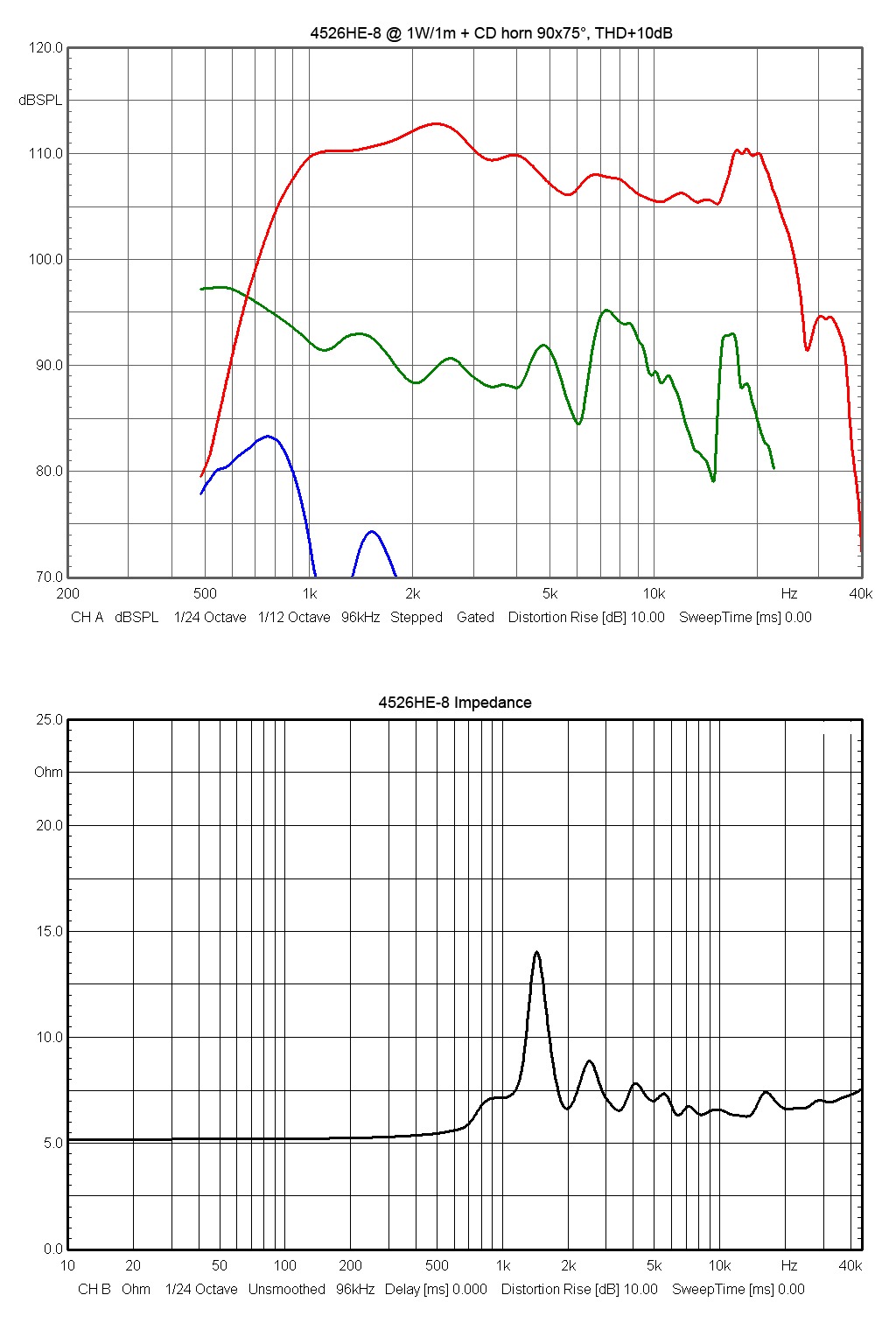
BMS 4526HE. 0.68" throat, 106dB output from 10khz+, 112dB output at 20khz
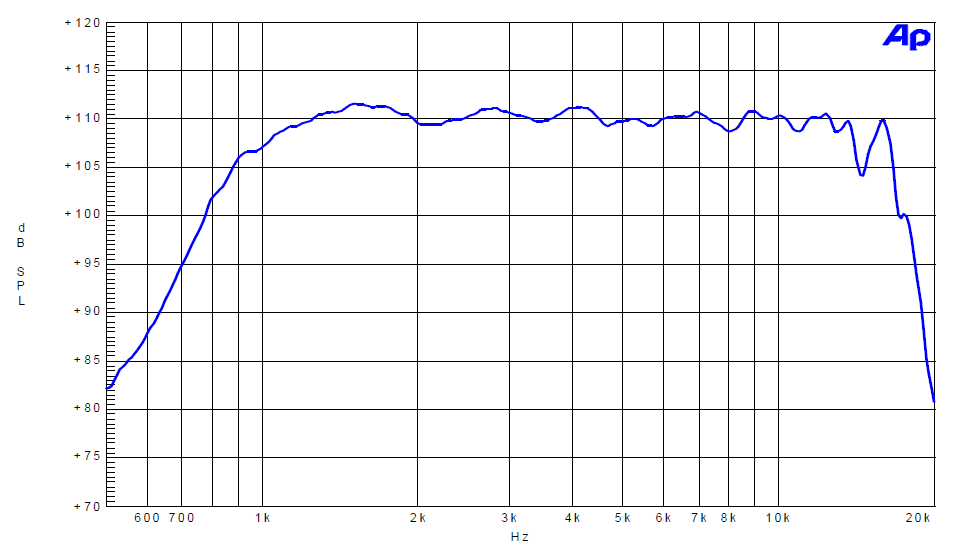
B&C DE250. 1" throat, 110dB output from 10khz+, 84dB output at 20khz
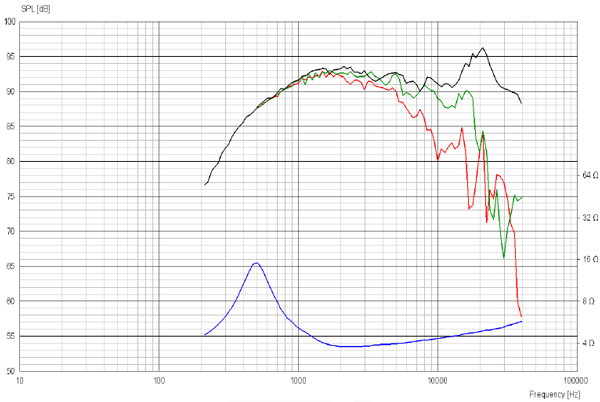
ScanSpeak D2604. 1" soft dome, 91dB output from 10khz+, 96db output at 20khz
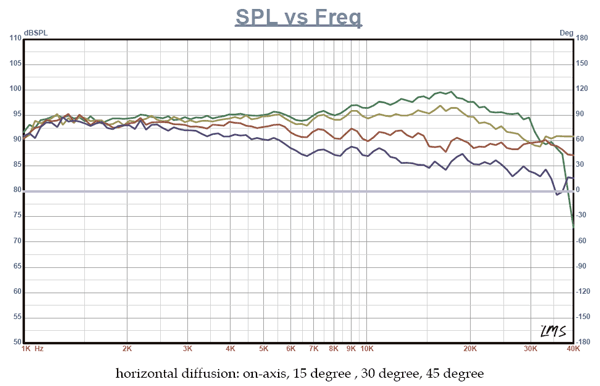
Fountek NEOCD3.5H ribbon tweeter, 95dB output from 10khz+, 98dB output at 20khz
Basically, if you look at the measurements, there are two devices capable of producing a LOT of high frequency output above 15khz:
1) ribbons
2) very very small compression drivers
Dome tweeters can get "in the ballpark", but they can't produce as much output at very high frequencies. The larger compression drivers have a difficult time getting up to 20khz whatsoever.
So I think that's one of the reasons that waveguides have a reputation for not having that "sparkle" up high. A waveguide is taking the energy, and it's spreading it into a wider beam. And because the beam is wider, the overall SPL level droops, which means that the SPL limit for a waveguide speaker is often determined by how it performs at 20khz. IE, if your waveguide loudspeaker is intended to play all the way to 20khz, you may need to apply a lot of EQ to raise up that top octave.

For instance, the JBL V20 has *three* dual diaphragm compression drivers, worth about $3000 for the tweeters alone, and it's sensitivity at 20khz is about 98dB! IE, about the same as a $50 ribbon tweeter. Now, obviously, the JBL can take 500 watts and reach SPLs that are completely impossible with a ribbon. But the "base" efficiency of a ribbon tweeter is really quite remarkable.
...but maybe with a slightly more narrow dispersion in order to avoid making the horns too large!
Best regards
Peter
Peter, according to Keele, it's the other way around -- a larger horn is required to make the dispersion narrower to the same lowest frequency.
https://www.xlrtechs.com/dbkeele.com/PDF/Keele%20(1975-05%20AES%20Preprint)%20-%20Whats%20So%20Sacred%20Exp%20Horns.pdf
Note that the angle is in the denominator, x (the width) goes up as the angle narrows.
Attachments
By my understanding, a constant directivity waveguide has about the same response flatness (assuming large enough waveguide for lower part of frequency range) as the compression driver has played into a plane-wave tube. The horns that make the response flatter, lifting the higher frequencies like say an exponential horn does, do so by squeezing the output power at higher frequencies into a smaller projection area.
But correct me if I'm wrong on this.
But correct me if I'm wrong on this.
- Home
- Loudspeakers
- Multi-Way
- Horns and waveguides 101
